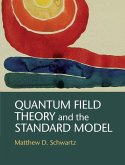Quantum field theory is the basic mathematical framework that is used to describe elementary particles. This textbook provides a complete and essential introduction to the subject. Assuming only an undergraduate knowledge of quantum mechanics and special relativity, this book is ideal for graduate students beginning the study of elementary particles. The step-by-step presentation begins with basic concepts illustrated by simple examples, and proceeds through historically important results to thorough treatments of modern topics such as the renormalization group, spinor-helicity methods for quark and gluon scattering, magnetic monopoles, instantons, supersymmetry, and the unification of forces. The book is written in a modular format, with each chapter as self-contained as possible, and with the necessary prerequisite material clearly identified. It is based on a year-long course given by the author and contains extensive problems, with password protected solutions available to lecturers at www.cambridge.org/9780521864497.
Dieser Download kann aus rechtlichen Gründen nur mit Rechnungsadresse in A, B, BG, CY, CZ, D, DK, EW, E, FIN, F, GR, HR, H, IRL, I, LT, L, LR, M, NL, PL, P, R, S, SLO, SK ausgeliefert werden.
'This accessible and conceptually structured introduction to quantum field theory will be of value not only to beginning students but also to practicing physicists interested in learning or reviewing specific topics. The book is organized in a modular fashion, which makes it easy to extract the basic information relevant to the reader's area(s) of interest. The material is presented in an intuitively clear and informal style. Foundational topics such as path integrals and Lorentz representations are included early in the exposition, as appropriate for a modern course; later material includes a detailed description of the Standard Model and other advanced topics such as instantons, supersymmetry, and unification, which are essential knowledge for working particle physicists, but which are not treated in most other field theory texts.' Washington Taylor, Massachusetts Institute of Technology
'I expect that this will be the textbook of choice for many quantum field theory courses. The presentation is straightforward and readable, with the author's easy-going 'voice' coming through in his writing. The organization into a large number of short chapters, with the prerequisites for each chapter clearly marked, makes the book flexible and easy to teach from or to read independently. A large and varied collection of special topics is available, depending on the interests of the instructor and the student.' Joseph Polchinski, University of California, Santa Barbara









